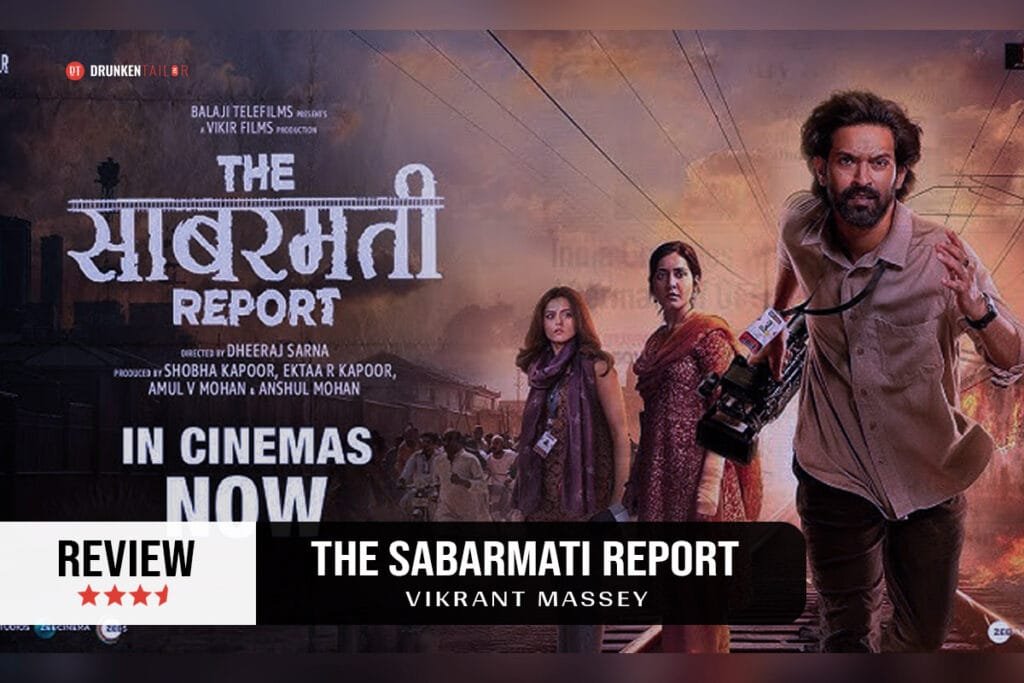“The Sabarmati Report” is a gripping cinematic examination of one of the most tragic and politically volatile events in recent Indian history – the Godhra train burning incident of 2002. Directed by Dheeraj Sarna, the film offers a nuanced perspective on the role of media and journalism in shaping public discourse around such sensitive issues.
Through the eyes of its central character, a photojournalist named Samar Kumar, the narrative delves into the complexities of truth-seeking amidst the chaos of communal violence and ideological conflicts.
The Sabarmati Report: A Compelling Cinematic Exploration
Cast
Vikrant Massey: as Samar Kumar: The lead character, a small-time reporter grappling with the aftermath of the Godhra incident.
Raashii Khanna: as Amrita Gill: A journalist who helps Samar in his quest for truth.
Riddhi Dogra: as Manika Rajpurohit: Another key character, representing the elite journalism perspective.
Tushar Phulke: as Lawyer Jethalal Makwana
The film is directed by Dheeraj Sarna, who replaced Ranjan Chandel during production. It is produced by Balaji Motion Pictures and Vikir Films Production.
Narrative Depth and Thematic Exploration
At the core of the film’s storytelling is the question of media responsibility and the thin line between objective reporting and propagandistic narrative-building. As Samar investigates the Godhra incident, he finds himself caught in the crosshairs of competing media factions, each with their own agenda and interpretation of the events. The film masterfully weaves together the personal struggles of the journalist protagonist with the broader social and political implications of the tragedy.
Through this central conflict, “The Sabarmati Report” raises profound questions about journalistic integrity, the nature of truth, and the role of the media in times of crisis. It challenges the audience to critically examine the ways in which information is framed, disseminated, and consumed, and how those processes can shape public perception and national discourse.

Performances and Character Development
The film’s success is largely attributable to the compelling performances of its lead actors. Vikrant Massey delivers a nuanced and powerful portrayal of Samar Kumar, the photojournalist at the heart of the narrative. Massey’s ability to convey the character’s internal turmoil, ethical dilemmas, and determination to uncover the truth is truly remarkable.
Complementing Massey’s performance is Raashii Khanna‘s portrayal of Amrita Gill, a journalist who represents a contrasting approach to reporting on the incident. Khanna’s character adds depth and complexity to the narrative, highlighting the multifaceted nature of media representation. Ridhi Dogra as Manika Rajpurohit provides a strong counterpoint, embodying the ideological conflicts within the media landscape.
The chemistry and interplay among the lead actors are exceptional, elevating the emotional weight of the film and drawing the audience deeper into the characters’ personal and professional struggles.

Visual Storytelling and Technical Aspects
The film’s visual language, crafted by cinematographer Amalendu Chaudhary, is a standout element. The cinematography seamlessly transitions between documentary-style immediacy and more poetic, composed sequences, mirroring the film’s delicate balance between factual reporting and emotional resonance.
The camera work effectively captures the tension and chaos of the unfolding events, while also highlighting the nuanced interplay of light and shadow, which serve as powerful metaphors for the film’s exploration of truth and obfuscation. The background score, composed by a talented team, provides subtle emotional cues without overwhelming the natural flow of the narrative.
While some reviews have noted that certain technical aspects, such as pacing, could have been executed with more finesse, the overall technical merit of “The Sabarmati Report” serves to elevate the cinematic experience and enhance the film’s thematic impact.
Critical Reception and Relevance
The Sabarmati Report has garnered a mix of critical responses, reflecting the complex and sensitive nature of its subject matter. Some reviewers have praised the film’s bold approach, awarding it high marks (3.5/5) for its unflinching exploration of the issues at hand. They have lauded the film’s ability to stimulate dialogue about media responsibility and the nature of truth in reporting.
Others, however, have been more measured in their assessment, citing concerns about the film’s execution and script cohesion. A review from Bollywood Hungama, for instance, awarded the film a (1.5/5) rating, acknowledging the standout performances but criticizing certain technical elements.
Regardless of the varied critical reception, “The Sabarmati Report” stands as a significant and relevant work of contemporary Indian cinema. In an era marked by increased media fragmentation and the proliferation of partisan narratives, the film’s exploration of journalistic integrity and the complexities of truth-seeking feels both timely and necessary.

Conclusion
“The Sabarmati Report” is a bold and thought-provoking cinematic endeavor that delves into the heart of one of India’s most contentious historical events. Through its compelling narrative, strong performances, and thoughtful visual storytelling, the film invites the audience to grapple with the moral and ethical dilemmas faced by journalists and media practitioners in times of crisis.
By raising critical questions about the responsibility of the media and the nature of truth, “The Sabarmati Report” transcends the boundaries of a typical historical drama, emerging as a work of cinematic significance that resonates with the pressing sociopolitical concerns of our time. For viewers interested in the intersection of journalism, social justice, and the power of media, this film offers a richly rewarding and intellectually stimulating experience.


